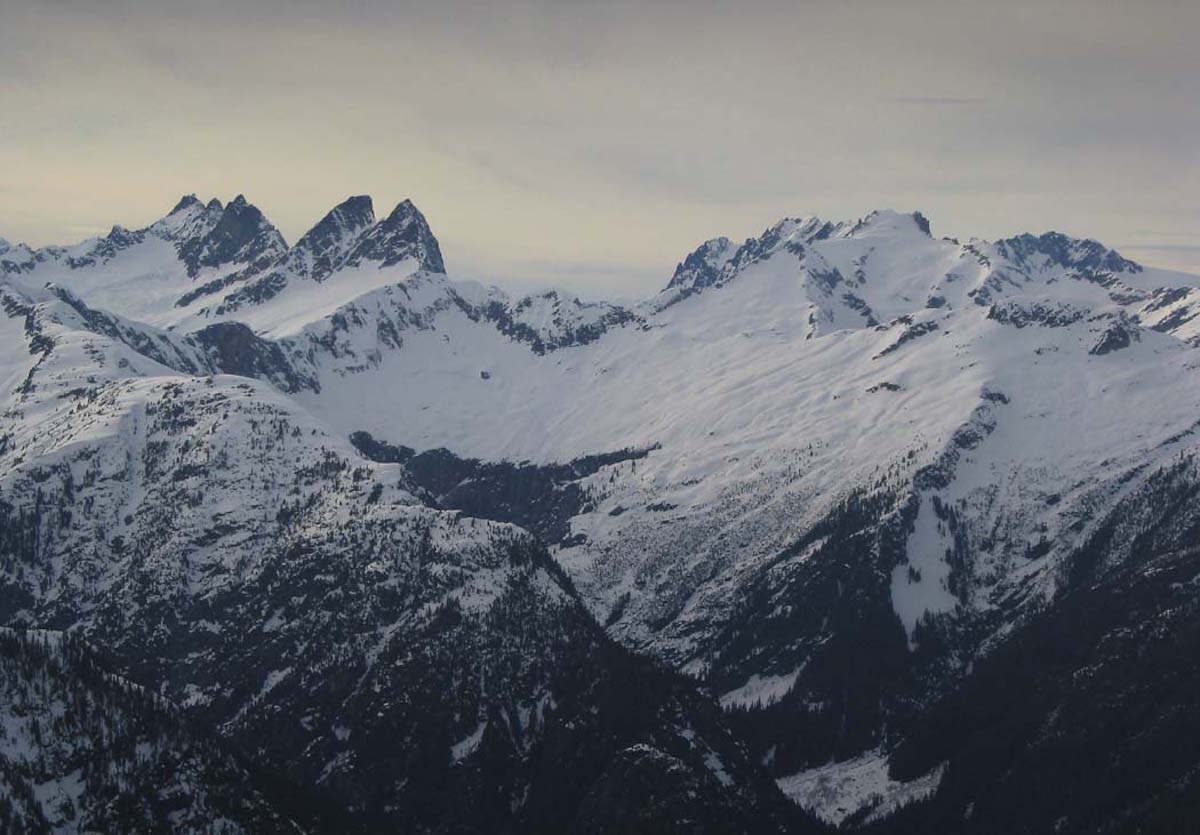
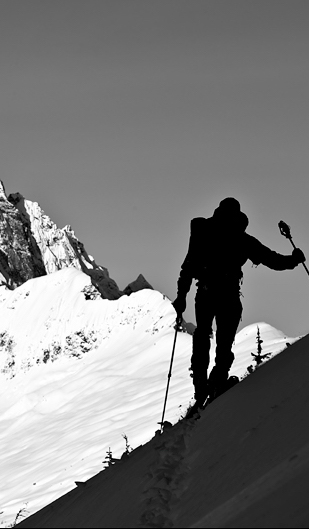
The idea to do a Picket Range Ski Traverse was the brain child of both Jason Hummel and Forrest Mcbrian. Basically I was a passenger and this is how a trip that would change my life came together.
February 17th 2010 presented a rare weather window indigenous to spring in the Cascades—6 days of clear skies and, most likely, stable, predictable maritime snowpack. The infrequent opportunity called for something long and arduous in the backcountry. Like most other mountaineers in the area, this was what I had waited for—a big weather window, and the opportunity to do something big with it.
As a splitboard mountaineer, finding touring partners often means looking beyond snowboarders toward the truly elite in sliding tool mountaineering (yeah, that often means skiers). Jason Hummel, though a skier, was a frequent traveling partner, good friend, and talented photographer. Traveling with him was a given for the upcoming window, but where we would go was yet to be determined. Jason had considered the Picket Range Ski Traverse many times before, and was knowledgeable about the area. He and I had talked for a while about doing a trip in the area.
The Picket Traverse Coming Together
Forrest McBrian had posted some impressive trip reports and was an esteemed guide, who had been eyeing the Pickets’ traverse for some time. He envisioned a midwinter reverse repeat of Lowell and Carl Skoog’s harrowing March Picket Range Ski Traverse, even if it meant going solo. Though winter seemed to be ending early this year (thanks, El Nino), we figured late February would count.
Excited emails from Forest to Jason and Jason to me put our little group together. We studied Lowell and Carl’s trip and their descriptions of the terrain, and made the decision to attempt the traverse within 24 hours of our hurried departure.
From the get go, we felt that this would be something huge. The question was whether we’d complete it, and whether mother nature would let us out alive.
Driving into the North Cascades
Packing light and essential was, well, essential. Crampons, ice axe, sleeping bag, sleeping pad, bivy, clean socks, skins, beacon, shovel, probe, and food quickly added up to 70 pounds. Forest had the packing down to a science. I think he ate ten pounds of cheese and ten pounds of sausage, but not much else on the trip. For some reason, I found this diet really humorous, though it made sense from a calories-to-weight ratio standpoint—especially compared to my repetitive, carb-laden meals of oatmeal and pasta. Jason, on the other hand, had to pack even lighter than we did, as he had a few extra pounds of camera equipment to tote with him, as well.
The low-lying forests near our starting point on Highway 20 would have been the most direct way to access the heart of the range, but they would have necessitated countless hours of bushwhacking. If the Pickets are America’s Alps, then their low-lying forests are the Cascades’ jungle swamps. Devil’s thorn, dense old growth, steep waterfalls, swamp-like melt areas, mud to your knees, and more devil’s thorn populate the landscape. Thinking such terrain would lend itself to frustration and problematic route finding, we chose not to bushwhack that area and instead opted for the scenic, exposed alpine approach via Sourdough Mountain and Stetattle Ridge.
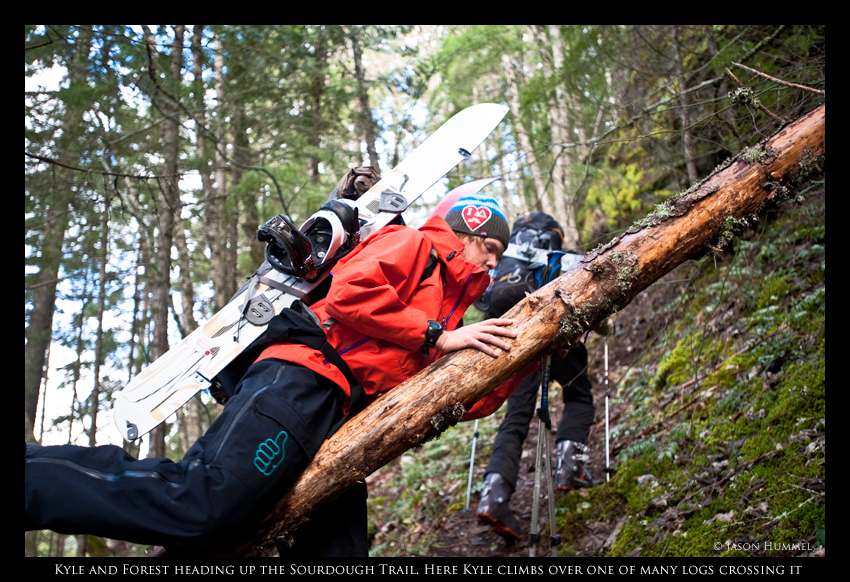
Leaving Diablo for Stetattle Ridge: Day 1 Travel
While the drive up Highway 20 was beautiful, we couldn’t yet see what we’d come to do. The first few hours of hiking, however, gave us a completely different viewpoint as we quickly gained elevation. For Forest and Jason, the view was familiar. To me, it was a whole new experience. The rugged views as we climbed in the afternoon sun were appetizer to what would be a visual feast of a journey. The small town of Diablo lay tiny, directly below us, while Mt. Davis’ rugged east face, a 5000 foot drop-off (reputed to be perhaps the largest vertical drop-off in the lower 48), lay directly west. As we continued up, other famous personalities came into view: Eldorado, Mount Logan, and Jack Mountain to name a few as we prepared for the Picket Range Ski Traverse.
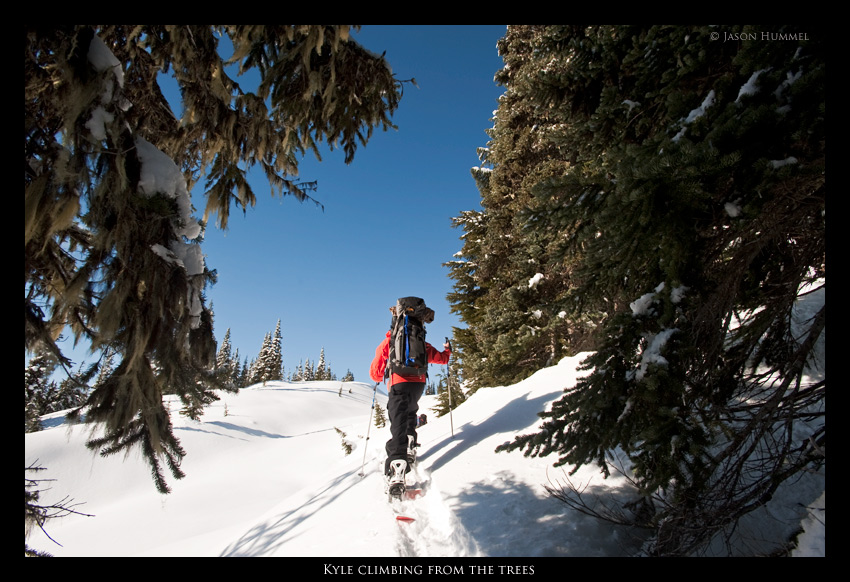
Soon, we were on snow and bootpacking up through the steep forest. Here, our countless rainstorms did us a service—the refrozen snow was solid, but did us a disservice as well—such stable purchase proved difficult for skinning and lent itself more toward bootpacking. Nonetheless, it was obvious that the area hadn’t seen snow in weeks, and we were reminded of what was looking like an earlier end to a warmer winter.
Gaining Stetattle Ridge
As we gained the ridge, sparse trees granted us views of the spine ahead—numerous highs and lows littered the landscape, so we decided it would be more efficient (especially for the skiers) to traverse. For the remainder of the day, we traveled in this fashion; ‘till the sun began to drop and it was time to construct what Jason began to refer to fondly as, our “snow coffins,” or homes for the night– trenches we dug in the snow to sleep in at the end of day 1 of the Picket Range Ski Traverse.
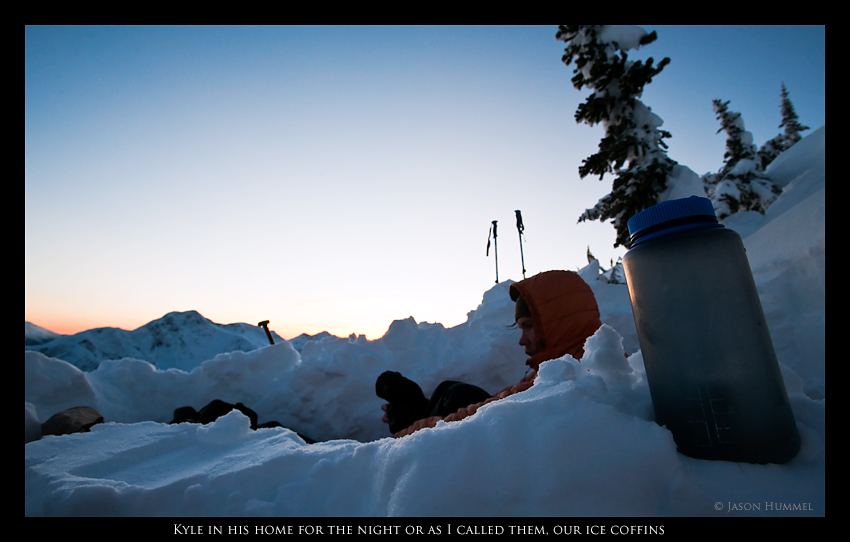
As is appropriate to a coffin without a lid, the live corpse inside (me) could only see straight up, but the stars were gorgeous on the cold, clear night. If gorgeous stars could provide warmth, in fact, we’d have been the coziest men alive, but as luck would have it, the dry air and heavy winds made for a restless night, especially for Jason, who had more trouble staying warm than Forest and I. That night, I was truly humbled by the gravity of the terrain around me—so vast, remote, and rugged.
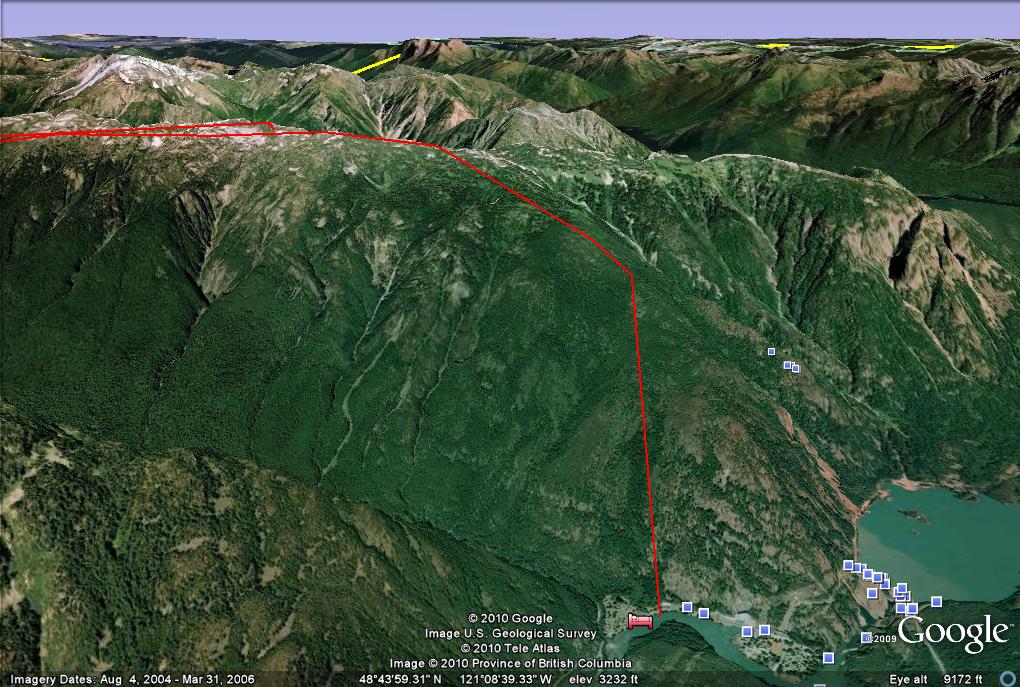
Day 2 of the Partial Picket Range Ski traverse
At 5 am, we awoke, and I felt strong as I pulled on my refrozen boots. We had planned for a long day, hoping to make McMillan Col.
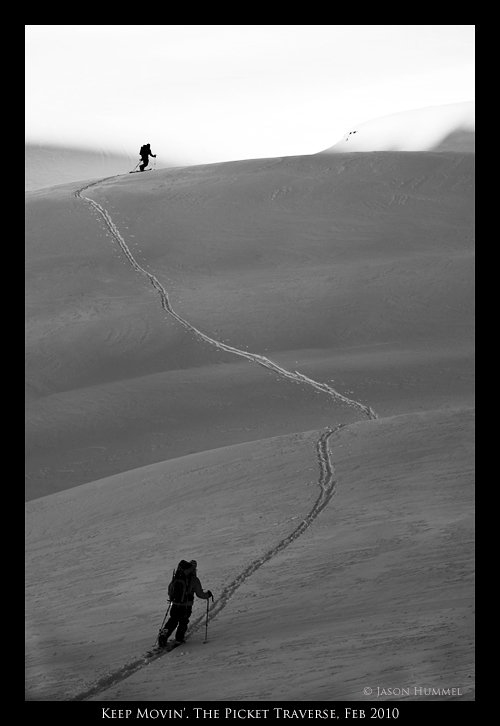
As with any traverse on a splitboard, uphill travel was easy but traversing with a very slight downhill grade was difficult. With the board in ski mode, one must slide haphazardly on oddly shaped skis downhill and then traverse up again, while in snowboard mode, as most will tell you, traversing is a chore for one side of the body or the other. Consequently, a splitboarder must approach terrain differently than a skier and will often practice a different route-finding process. Of course, I knew this all along and expected this trip to be no different. One such instance was our approach of Stetattle Ridge. Though Forest and Jason could have traversed directly across, it was more efficient for me to get to the highpoint and then snowboard down.
Since I was breaking the skin track and we did not want to cross above or below one another, I turned to see that Forest was following my skin track, and that we’d all be starting our traverse from the summit.
Finally, after a day and a half of traversing, I peeled the skins off of my splitboard and prepared for my first downhill ride of the trip—down the low col separating the ridge and Elephant Butte.
Heading out to Elephant Butte
The snow on the descent was nice—windscoured powder up top where mellow rollers reined, and carveable mank further down, where cliffs and gullies required a more technical approach. Once at the col, we took a short water break and noted we were moving a bit slower than planned, but it was still early in the day. As we started skinning up to Elephant Butte, the terrain became increasingly technical, with windscoured surfaces, solid ice, and cliffs within the space of a few moments. It was like navigating through a maze—one simple mistake would lead to a dead end. Once we made it to Elephant Butte, it would be easy traversing all the way to McMillan Col and get into the Picket Range Ski Traverse.
Perhaps with our eye on the prize (McMillan was the gateway to the terrain we’d come for), we began to travel a bit more sloppily. I announced I’d traverse down a bit and then climb up, while Jason and Forest stopped to take off their skins to take advantage of a long, downward-sloping ski traverse. I dropped in and began traversing, quickly arriving at a low bench halfway up a steep roller that would allow access to higher terrain. A large rock protruded out into the slope, and I rested beneath it for a moment, knowing that to minimize exposure, I’d need to traverse quickly across the steep slope beyond. All of a sudden, while standing in the cliff’s shadow, I heard a huge WHOOMP and felt the snowpack move.
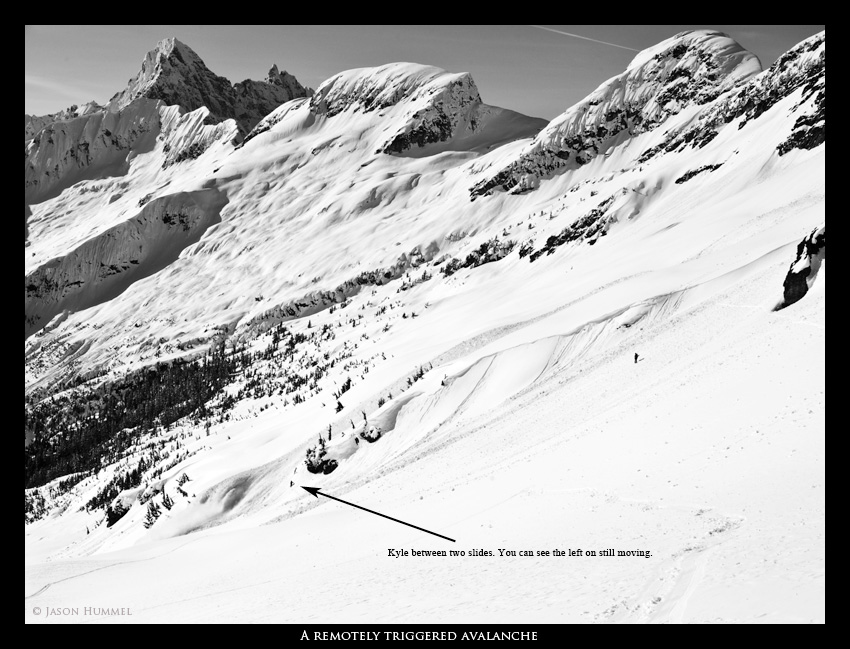
A Slab Avalanche on Elephant Butte in the Picket Range
I knew something had gone terribly wrong and was horrified to hear a low, loud, far-off rumble getting closer by the second. Some confused expletive no doubt escaped my lips because Jason, who was above and behind and could see the whole thing yelled, “stay where you are!” A few seconds later, the large wetslide ripped past me on either side and snow spilled over the rock to the space below me at incredibly high speed.
Large bricks of cascade concrete poured by for what felt like hours, my heart racing all the while. I couldn’t help but consider what my fate would have been if I’d been two minutes into my traverse across the slope.
It turned out that Forest, who had commenced a ski traverse behind and above me, with Jason following, had accidentally triggered a remote slab fracture on a southwest facing slope 500 feet above him. Once the first slide was triggered, another one in the distance went off. Like dominos, swaths of football-field wide slope slid from near the ridge down the valley. We counted at least three distinct triggering events within the course of a minute. We estimated that the initial slide was at least 8 inches deep, and ran a long ways, down the entire bowl, from nearly the ridge.
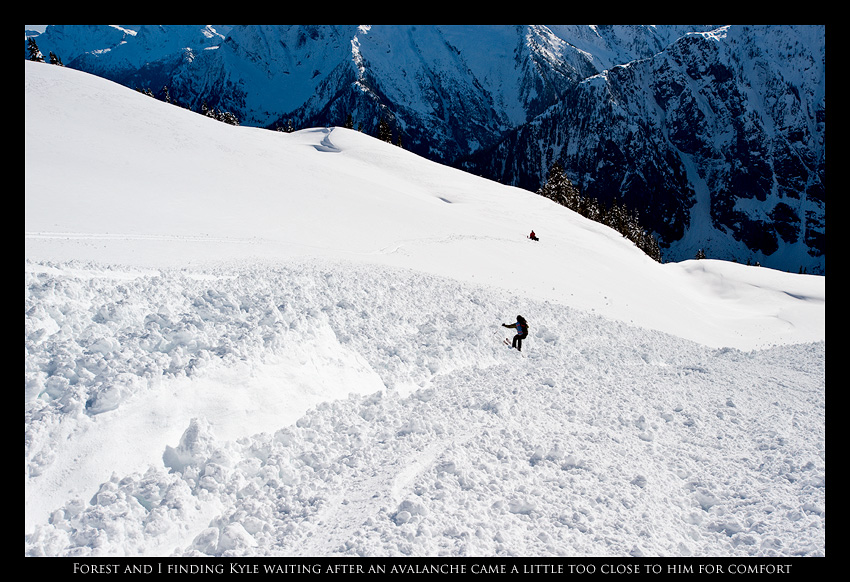
Our Second Camp on the Picket Range Traverse
As soon as I gained my composure, I scrambled to a safer zone and waited as Forest and Jason skied over and down to me. It was early afternoon but the experience had shaken all of us, and we concluded that we were finished traveling for the day, as the snowpack was (obviously) unstable. That night as I prepared food and basked in the afternoon light, I would occasional glance at the debris pile off in the not so far distance, and ask myself “what if…” before falling asleep in my freshly dug out trench.
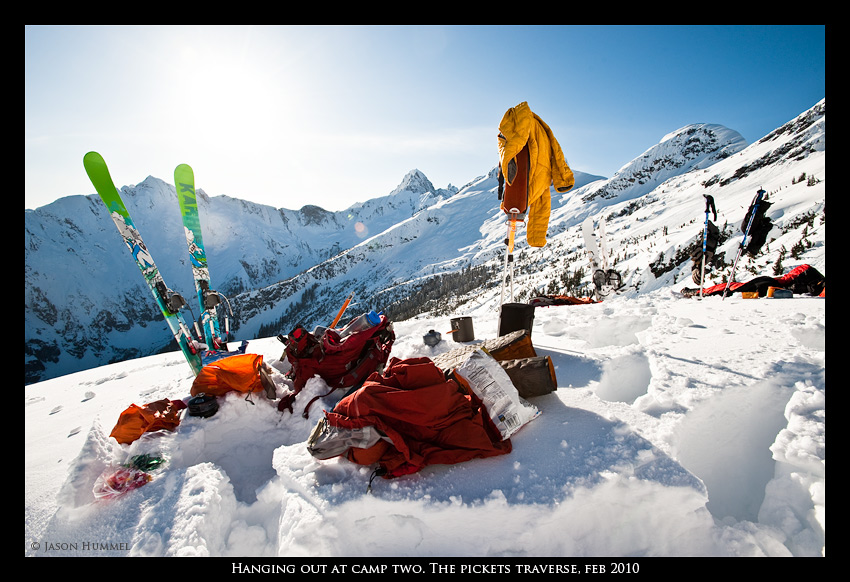
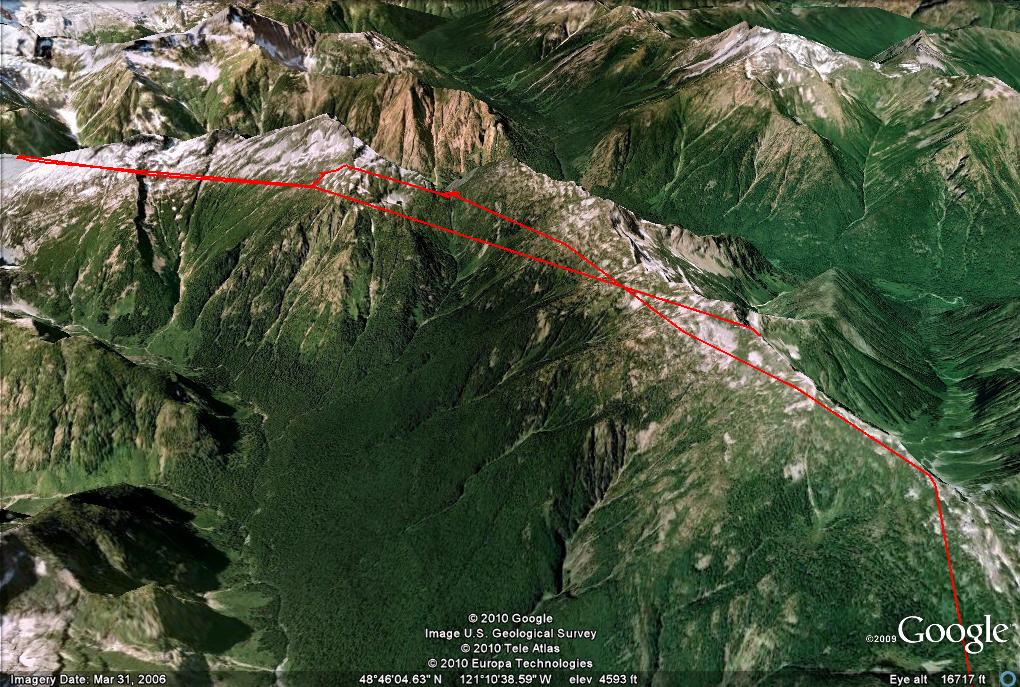
Day 3: To Commit or To Turn Back
The next morning, we awoke early and noted that some areas had slid, but many had not. Nonetheless, the ground was refrozen over night and would provide safer travel in the morning hours. Initially, Jason and I were hesitant about continuing on. But Forest, who had planned this journey for some time, and was set on going on, even if it meant doing so alone. He convinced us to make our decision from McMillan Col.
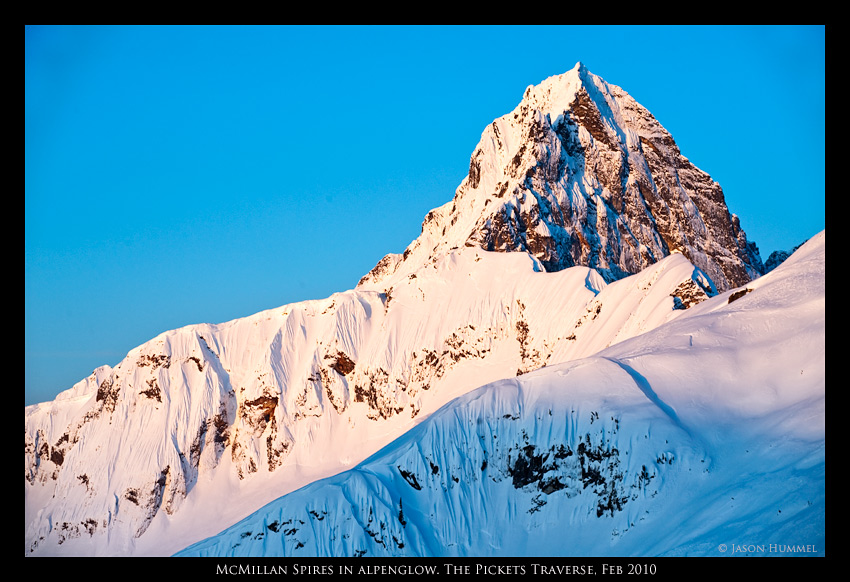
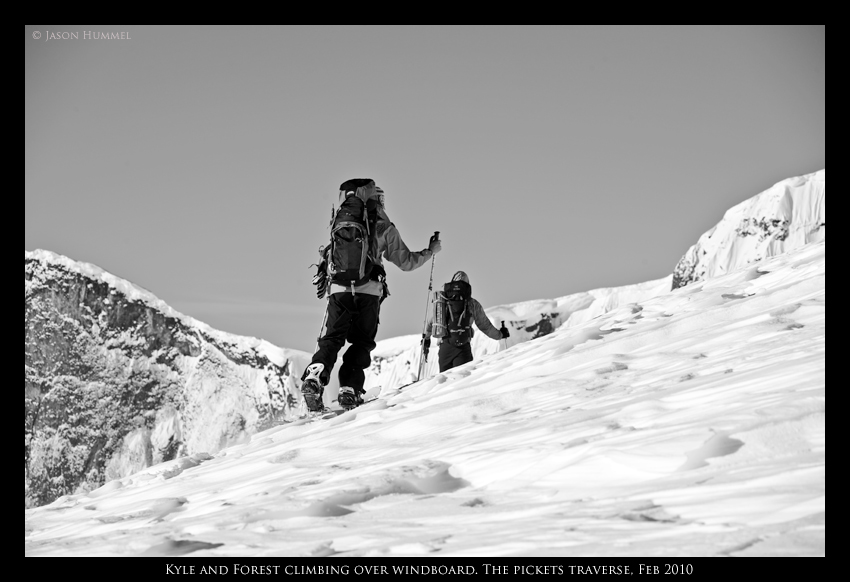
We traversed along Elephant Butte trying to minimize our exposure. The completion of each convex roller was met with relief, as we felt as if we’d cheated death just one more time. When we finally arrived at McMillan Col, we could see the terrain beyond. Fury was aptly named, and the route we’d be attempting was a committing one, to say the least. The next few days would be filled with convex rollers and high alpine terrain without a tree in sight. Much of the travel would be over southwest-facing slopes with 1000’ cliffs below them. A slide or a misstep would mean death.
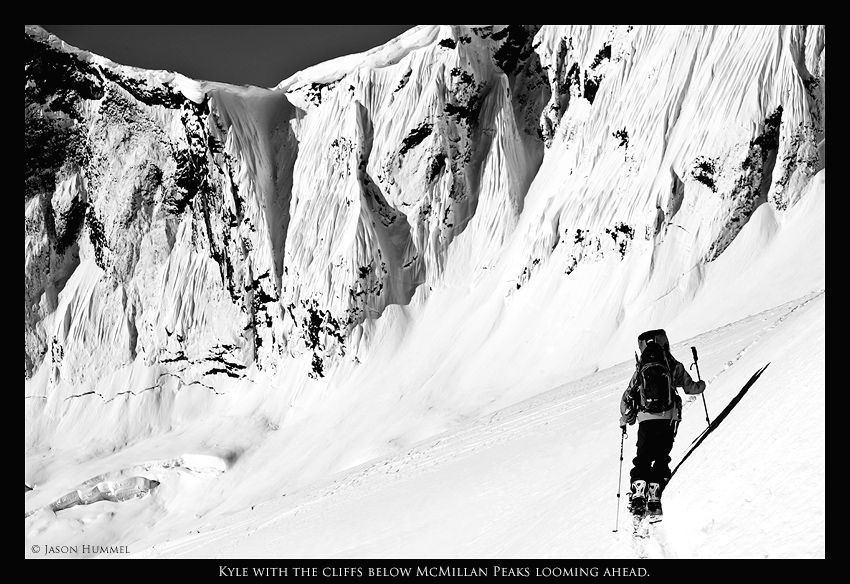
Heading to McMillan Col
If we continued, moving quickly through the terrain would be key, and I knew I’d often have to choose a different route than Jason and Forest, making it hard to avoid traveling (remotely or not) above or below one another. I felt like we were charging foolhardy into a minefield. Furthermore, I didn’t want to risk our safety further by traveling at different elevations from one another. My instinct was to run, my ears still ringing with the sound of the slide from the day before. Forest was set on continuing, and as I turned to head back, Jason chose to continue as well. Nonetheless, I felt as though I’d made the right choice. Getting out safely would be an art and a puzzle, and doing so alone was more risky. But I felt that it was riskier still for us to travel together on our intended path.
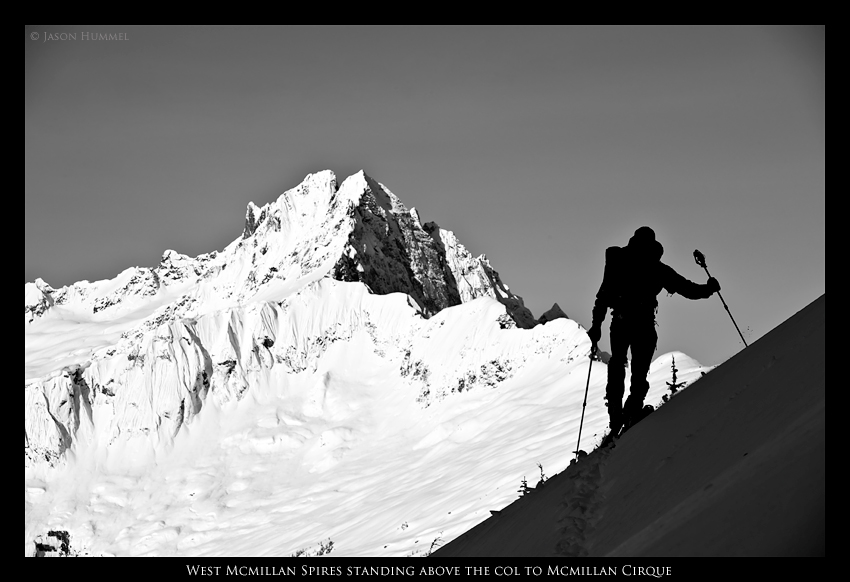
A moment passed, and I was alone with the majesty of the isolated mountains. I knew as the day progressed, the snowpack would warm and become increasingly unstable. So, I began to travel as quickly as possible back over the avy debris from the day before. As soon as the snowpack began to heat again and whoomping sounds commenced in the distance, I scrambled to a safe zone and camped. I decided I would wake early and try to make it out in a single-day push, traveling on snow in the morning and down through the trees as the snowpack heated.
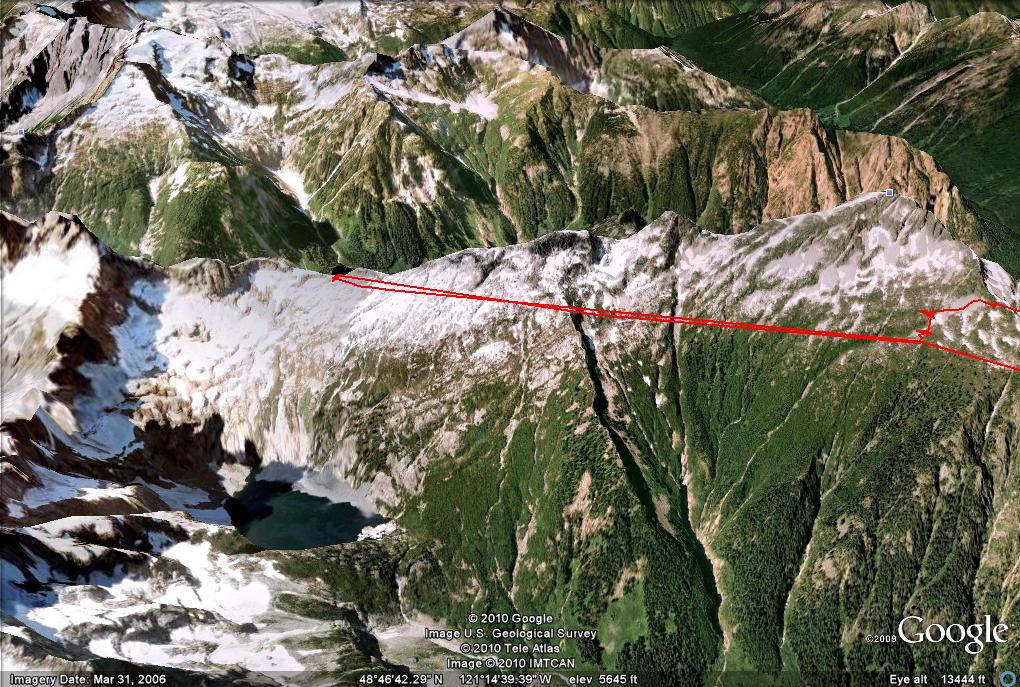
Day 4: Abandoning Isolation Returning From the Picket Range
At 4 am, I awoke and boiled water for a quick breakfast of all the oatmeal I could eat. Lunch, I knew, might be out of the question, so calorie loading now was key. As I climbed up Elephant Col, the sun rose around me, and my first descent of the day commenced. Large couloirs and chutes seduced me on the way down, but my memory of the terrain was that it was often deceiving, with huge cliffs and dead-ends around every corner. So, I followed our skin track back for the most part—a mellow ride, but a safe one, nonetheless.
At one point I saw what looked to be a chute that allowed easy access to the low col but after some thinking decided against dropping in. To my horror, I looked back up after traversing around it and realized that the beautiful chute ended in an equally beautiful 300’ cliff.
As I traversed, I decided that it would be more efficient to summit the high points along the way. I’d skin up one side of a highpoint, and bootpack to the ridge for some amazing views, and then slide down the other side on my board. The views were good, but I was constantly worried about Jason and Forest—it didn’t look like there were tracks yet on Mt. Fury (where they had planned to be for the day), and I feared something terrible had happened to them. Resting on occasion in the sunlight, I was struck again by the majesty, the fury, the harshness of the Picket Range, and how its harshness made it oddly beautiful.
Returning to the Car in Diablo
Before I knew it, I was dropping quickly toward the small town of Diablo, feeling victorious for having made it out alive, and praying that Jason and Forest would do the same. Near the trailhead, I washed my dry sweat in a stream and drank as much water as I could. The taste was perfect and delicious. By now, my feet were blistering and my stomach turning from the journey. I relished the dry clothes and brownies we had waiting in the car, the later of which I promptly devoured (sorry, Jason.)
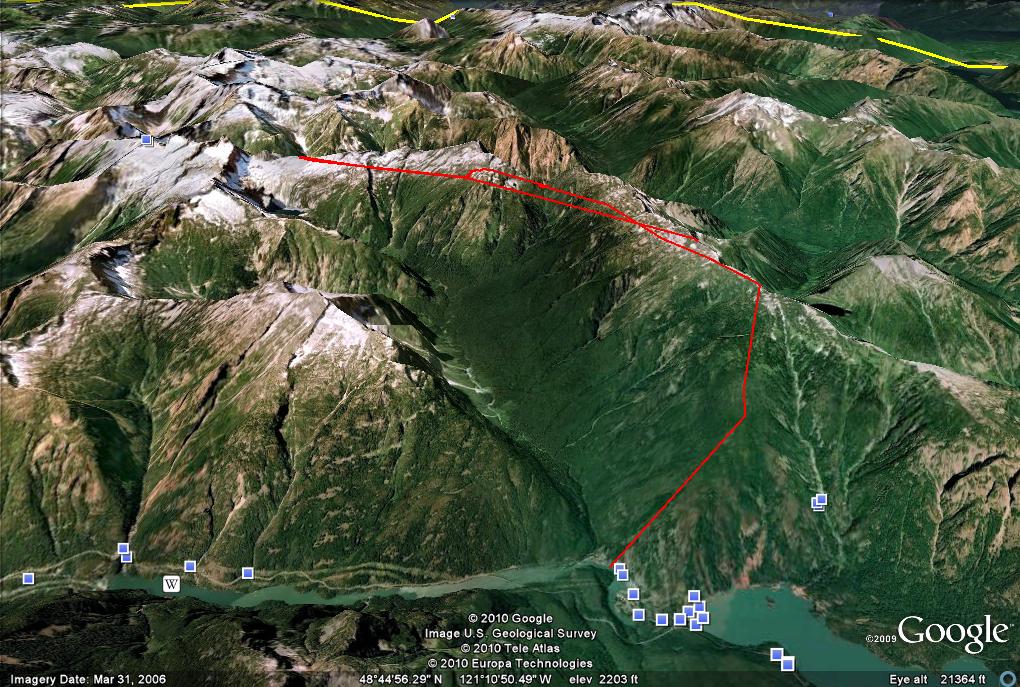
Day 5: A Waiting Game and Descent of Mount Ruth
I had no idea what Jason and Forest were going through, but I knew the plan for today was to descend Challenger. Not wanting to abandon their point of return (Hannigan Pass) for another area, nor wanting to remain stationary while I waited and dreamed up deathly scenarios, I opted for a summit and descent of the nearby Mount Ruth. So, I duct-taped my blisters and headed out to Ruth. Thinking I’d see many others with the glorious weather, I followed a well-made skin track up to the summit, but never encountered a soul. From the summit I sat and waited, but never saw movement or ski lines on Challenger. As the sun began to set, I convinced myself that the lines might not be visible and that Jason and Forest could still be okay.
Nonetheless, it was disturbing to see no evidence of life. I raced daylight to the bottom and had a restless night of sleeping in the car. I decided that if they did not return by Wednesday, I would contact search and rescue.
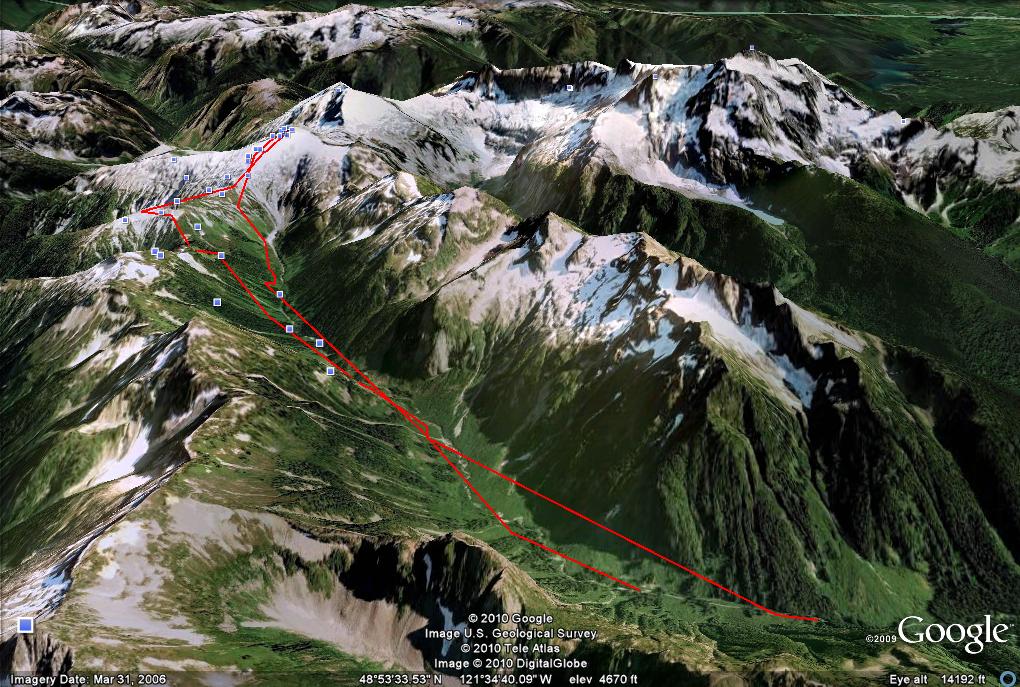
Day 6: Against All Odds, Jason and Forrest are Safe!
The next morning, I didn’t want to abandon the trailhead at Hannigan Pass (our intended exit route), so I restlessly sat reading Rainier Burgendorf’s 100 Classic Backcountry Tours and poured over a Washington Topo Map for hours. Occasionally, I would glance up the road in hopes of seeing signs of life. A watched road never produces hikers, but finally, in the afternoon sun, two silhouettes emerged radiant but exhausted. I was in disbelief and awe as we packed their things into the car and headed to Bellingham for Mexican food.
The feat was stunning, the adventure harrowing, and the outcome the best—we all survived, we were all unscathed, and the weather was perfect. The feat of Jason and Forest demands respect, the beauty and terror of the Picket Range Ski Traverse motivates me to explore it further, and the solitude of my personal journey will forever be seared into my brain.
Thank you for reading this trip report on an attempt of the Picket Traverse
If you want to see more ski tours within the the Highway 20 corridor check out this link.